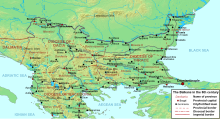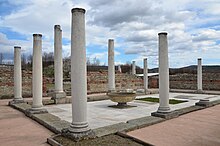| Dacia Ripensis | |||||||||
|---|---|---|---|---|---|---|---|---|---|
| Province of Roman Empire | |||||||||
| c. 283 – 586 | |||||||||
 The northern Balkans, including Dacia Ripensis, in the 6th century | |||||||||
| Capital | Ratiaria (now in Vidin Province, Bulgaria) | ||||||||
| History | |||||||||
• Evacuation of Dacia Traiana, creation of Dacia Aureliana | 271 | ||||||||
• Dacia Aureliana partitioned | before AD 285 280s | ||||||||
• Devastated by Avar invasion | 586 | ||||||||
| |||||||||
Dacia Ripensis (lit. 'riparian Dacia') was the name of a Roman province in the northern Balkan peninsula, immediately south of the Middle Danube.[1] Its capital was Ratiaria (modern Archar, Bulgaria).[2] It was a district less urban than neighbouring Dacia Mediterranea and more militarized; "military camps and forts, rather than cities, were typical of the province".[3] Besides Ratiaria, Oescus was the major settlement.[3]
Dacia Ripensis was one of the "Two Dacias" established south of the Danube in the late 3rd century.[1] The Roman emperor Aurelian (r. 270–275) abandoned the province of Roman Dacia established by Trajan (r. 98–117) in 106 AD on the northern bank of the river, and created the two new "Dacias" between the existing provinces of Moesia Prima (upstream) and Moesia Secunda (downstream).[1][3] The northern part of Aurelian's Dacia Aureliana is attested as "Dacia Ripensis" in 343/4.[1] The southern part, with its capital at Serdica (modern Sofia) was known as Dacia Mediterranea.[1]
According to the Laterculus Veronensis, both provinces were part of the Diocese of Moesiae after the empire was divided into dioeceses during the reign of Constantine the Great (r. 306–337), but by the time of the Notitia Dignitatum they were part of the Diocese of Thrace. According to the Notitia, Dacia Ripensis was governed by a praeses, while the governor of Dacia Mediterranea was a more senior consularis. Dacia Ripensis was under the authority of the Praetorian prefecture of Illyricum.
Dacia Ripensis flourished in the mid-4th century, and some forts on the northern bank of the Danube were recovered by the Romans. In the 5th century Priscus described Ratiaria as large and densely populated. In the 6th century, Hierocles's Late Greek Synecdemus identifies Ratiera as the principal city of the province, calling the province Δακία Παραποτάμια, Dakía Parapotámia, 'Dacia-by-the-river', though Procopius referred to it as Ῥιπησία, Rhipēsía.[4]
In 535, emperor Justinian I (527-565) created the Archbishopric of Justiniana Prima as a regional primacy with ecclesiastical jurisdiction over all provinces of the Diocese of Dacia, including the province of Dacia Ripensis.[5]


- ^ a b c d e De Sena, Eric C.; Nicholson, Oliver (2018), Nicholson, Oliver (ed.), "Dacia Ripensis and Dacia Mediterranea", The Oxford Dictionary of Late Antiquity, Oxford University Press, doi:10.1093/acref/9780198662778.001.0001, ISBN 978-0-19-866277-8, retrieved 2020-08-25
- ^ De Sena, Eric C.; Nicholson, Oliver (2018), Nicholson, Oliver (ed.), "Ratiaria (mod. Archar, Bulgaria)", The Oxford Dictionary of Late Antiquity (online ed.), Oxford University Press, doi:10.1093/acref/9780198662778.001.0001, ISBN 978-0-19-866277-8, retrieved 2020-08-25
- ^ a b c Kazdan, Alexander P. (2005) [1991], Kazhdan, Alexander P. (ed.), "Dacia", The Oxford Dictionary of Byzantium (online ed.), Oxford University Press, doi:10.1093/acref/9780195046526.001.0001, ISBN 978-0-19-504652-6, retrieved 2020-08-25
- ^ Hierocles, Synecdemus, 655.1. Procopius, De Aedificiis, 4.5.11.
- ^ Turlej 2016, p. 47-86.